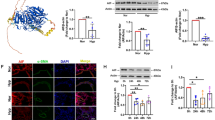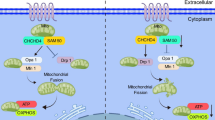Abstract
In this study, we investigated the role of peroxisome proliferator-activated receptor γ (PPARγ) on store-operated calcium entry (SOCE) and expression of the main store-operated calcium channel (SOCCs) components, canonical transient receptor potential (TRPC) in chronic hypoxia (CH)-induced pulmonary hypertension (CHPH) rat models. Small interfering RNA (siRNA) knockdown and adenoviral overexpression strategies were constructed for loss-of-function and gain-of-function experiments. PPARγ agonist rosiglitazone attenuates the pathogenesis of CHPH and suppresses Hif-1α, TRPC1, TRPC6 expression in the distal pulmonary arteries (PA), and SOCE in freshly isolated rat distal pulmonary arterial smooth muscle cells (PASMCs). By comprehensive use of knockdown and overexpression studies, and bioinformatical analysis of the TRPC gene promoter and luciferase reporter assay, we demonstrated that PPARγ exerts roles of anti-proliferation, anti-migration, and pro-apoptosis in PASMCs, likely by inhibiting the elevated SOCE and TRPC expression. These effects were inhibited under the conditions of hypoxia or Hif-1α accumulation. We also found that under hypoxia, accumulated Hif-1α protein acts as upstream of suppressed PPARγ level; however, targeted PPARγ rescue acts as negative feedback on suppressing Hif-1α level and Hif-1α mediated signaling pathway. PPARγ inhibits CHPH by targeting SOCE and TRPC via inhibiting Hif-1α expression and signaling transduction.
Key messages
-
Rosiglitazone protects PH by normalizing RVSP but not right ventricle hypotrophy.
-
PPARγ inhibits PASMCs proliferation via targeting SOCE and TRPC by suppressing Hif-1α.
-
PPARγ and Hif-1α share mutual inhibitory regulation in PASMCs.
-
PPARγ restoration might be a beneficial strategy for PH treatment.








Similar content being viewed by others
References
Golovina VA, Platoshyn O, Bailey CL, Wang J, Limsuwan A, Sweeney M, Rubin LJ, Yuan JX (2001) Upregulated TRP and enhanced capacitative Ca(2+) entry in human pulmonary artery myocytes during proliferation. Am J Physiol Heart Circ Physiol 280:H746–H755
Wang J, Shimoda LA, Sylvester JT (2004) Capacitative calcium entry and TRPC channel proteins are expressed in rat distal pulmonary arterial smooth muscle. Am J Physiol Lung Cell Mol Physiol 286:L848–L858
Sweeney M, Yu Y, Platoshyn O, Zhang S, McDaniel SS, Yuan JX (2002) Inhibition of endogenous TRP1 decreases capacitative Ca2+ entry and attenuates pulmonary artery smooth muscle cell proliferation. Am J Physiol Lung Cell Mol Physiol 283:L144–L155
Brough GH, Wu S, Cioffi D, Moore TM, Li M, Dean N, Stevens T (2001) Contribution of endogenously expressed Trp1 to a Ca2+−selective, store-operated Ca2+ entry pathway. FASEB J 15:1727–1738
Cioffi DL, Wu S, Stevens T (2003) On the endothelial cell I(SOC). Cell Calcium 33:323–336
Lin MJ, Leung GP, Zhang WM, Yang XR, Yip KP, Tse CM, Sham JS (2004) Chronic hypoxia-induced upregulation of store-operated and receptor-operated Ca2+ channels in pulmonary arterial smooth muscle cells: a novel mechanism of hypoxic pulmonary hypertension. Circ Res 95:496–505
Jiang BH, Rue E, Wang GL, Roe R, Semenza GL (1996) Dimerization, DNA binding, and transactivation properties of hypoxia-inducible factor 1. J Biol Chem 271:17771–17778
Huang LE, Gu J, Schau M, Bunn HF (1998) Regulation of hypoxia-inducible factor 1alpha is mediated by an O2-dependent degradation domain via the ubiquitin-proteasome pathway. Proc Natl Acad Sci U S A 95:7987–7992
Semenza GL (1998) Hypoxia-inducible factor 1: master regulator of O2 homeostasis. Curr Opin Genet Dev 8:588–594
Semenza GL (2000) Expression of hypoxia-inducible factor 1: mechanisms and consequences. Biochem Pharmacol 59:47–53
Wang J, Weigand L, Lu W, Sylvester JT, Semenza GL, Shimoda LA (2006) Hypoxia inducible factor 1 mediates hypoxia-induced TRPC expression and elevated intracellular Ca2+ in pulmonary arterial smooth muscle cells. Circ Res 98:1528–1537
Ameshima S, Golpon H, Cool CD, Chan D, Vandivier RW, Gardai SJ, Wick M, Nemenoff RA, Geraci MW, Voelkel NF (2003) Peroxisome proliferator-activated receptor gamma (PPARgamma) expression is decreased in pulmonary hypertension and affects endothelial cell growth. Circ Res 92:1162–1169
Michalik L, Auwerx J, Berger JP, Chatterjee VK, Glass CK, Gonzalez FJ, Grimaldi PA, Kadowaki T, Lazar MA, O'Rahilly S et al (2006) International Union of Pharmacology. LXI. Peroxisome proliferator-activated receptors. Pharmacol Rev 58:726–741
Issemann I, Green S (1990) Activation of a member of the steroid hormone receptor superfamily by peroxisome proliferators. Nature 347:645–650
Gearing KL, Gottlicher M, Teboul M, Widmark E, Gustafsson JA (1993) Interaction of the peroxisome-proliferator-activated receptor and retinoid X receptor. Proc Natl Acad Sci U S A 90:1440–1444
Yki-Jarvinen H (2004) Thiazolidinediones. N Engl J Med 351:1106–1118
Matsuda Y, Hoshikawa Y, Ameshima S, Suzuki S, Okada Y, Tabata T, Sugawara T, Matsumura Y, Kondo T (2005) Effects of peroxisome proliferator-activated receptor gamma ligands on monocrotaline-induced pulmonary hypertension in rats. Nihon Kokyuki Gakkai Zasshi 43:283–288
Crossno JT Jr, Garat CV, Reusch JE, Morris KG, Dempsey EC, McMurtry IF, Stenmark KR, Klemm DJ (2007) Rosiglitazone attenuates hypoxia-induced pulmonary arterial remodeling. Am J Physiol Lung Cell Mol Physiol 292:L885–L897
Yu AY, Shimoda LA, Iyer NV, Huso DL, Sun X, McWilliams R, Beaty T, Sham JS, Wiener CM, Sylvester JT et al (1999) Impaired physiological responses to chronic hypoxia in mice partially deficient for hypoxia-inducible factor 1alpha. J Clin Invest 103:691–696
Godfrey BJ, Akileswaran L, Gold MH (1994) A reporter gene construct for studying the regulation of manganese peroxidase gene expression. Appl Environ Microbiol 60:1353–1358
Lu W, Ran P, Zhang D, Peng G, Li B, Zhong N, Wang J (2010) Sildenafil inhibits chronically hypoxic upregulation of canonical transient receptor potential expression in rat pulmonary arterial smooth muscle. Am J Physiol Cell Physiol 298:C114–C123
Wang J, Yang K, Xu L, Zhang Y, Lai N, Jiang H, Zhong N, Ran P, Lu W (2013) Sildenafil inhibits hypoxia-induced transient receptor potential canonical protein expression in pulmonary arterial smooth muscle via cGMP-PKG-PPARgamma axis. Am J Respir Cell Mol Biol 49:231–240
Nissen SE, Wolski K (2007) Effect of rosiglitazone on the risk of myocardial infarction and death from cardiovascular causes. N Engl J Med 356:2457–2471
Collins AR, Meehan WP, Kintscher U, Jackson S, Wakino S, Noh G, Palinski W, Hsueh WA, Law RE (2001) Troglitazone inhibits formation of early atherosclerotic lesions in diabetic and nondiabetic low density lipoprotein receptor-deficient mice. Arterioscler Thromb Vasc Biol 21:365–371
Li AC, Brown KK, Silvestre MJ, Willson TM, Palinski W, Glass CK (2000) Peroxisome proliferator-activated receptor gamma ligands inhibit development of atherosclerosis in LDL receptor-deficient mice. J Clin Invest 106:523–531
Nisbet RE, Bland JM, Kleinhenz DJ, Mitchell PO, Walp ER, Sutliff RL, Hart CM (2010) Rosiglitazone attenuates chronic hypoxia-induced pulmonary hypertension in a mouse model. Am J Respir Cell Mol Biol 42:482–490
Goetze S, Xi XP, Kawano H, Gotlibowski T, Fleck E, Hsueh WA, Law RE (1999) PPAR gamma-ligands inhibit migration mediated by multiple chemoattractants in vascular smooth muscle cells. J Cardiovasc Pharmacol 33:798–806
Law RE, Goetze S, Xi XP, Jackson S, Kawano Y, Demer L, Fishbein MC, Meehan WP, Hsueh WA (2000) Expression and function of PPARgamma in rat and human vascular smooth muscle cells. Circulation 101:1311–1318
Marx N, Schonbeck U, Lazar MA, Libby P, Plutzky J (1998) Peroxisome proliferator-activated receptor gamma activators inhibit gene expression and migration in human vascular smooth muscle cells. Circ Res 83:1097–1103
Burgess HA, Daugherty LE, Thatcher TH, Lakatos HF, Ray DM, Redonnet M, Phipps RP, Sime PJ (2005) PPARgamma agonists inhibit TGF-beta induced pulmonary myofibroblast differentiation and collagen production: implications for therapy of lung fibrosis. Am J Physiol Lung Cell Mol Physiol 288:L1146–L1153
Stenmark KR, Mecham RP (1997) Cellular and molecular mechanisms of pulmonary vascular remodeling. Annu Rev Physiol 59:89–144
Shimoda LA, Sham JS, Shimoda TH, Sylvester JT (2000) L-type Ca(2+) channels, resting [Ca(2+)](i), and ET-1-induced responses in chronically hypoxic pulmonary myocytes. Am J Physiol Lung Cell Mol Physiol 279:L884–L894
Yun Z, Maecker HL, Johnson RS, Giaccia AJ (2002) Inhibition of PPAR gamma 2 gene expression by the HIF-1-regulated gene DEC1/Stra13: a mechanism for regulation of adipogenesis by hypoxia. Dev Cell 2:331–341
Krishnan J, Suter M, Windak R, Krebs T, Felley A, Montessuit C, Tokarska-Schlattner M, Aasum E, Bogdanova A, Perriard E et al (2009) Activation of a HIF1alpha-PPARgamma axis underlies the integration of glycolytic and lipid anabolic pathways in pathologic cardiac hypertrophy. Cell Metab 9:512–524
Lee KS, Kim SR, Park SJ, Park HS, Min KH, Jin SM, Lee MK, Kim UH, Lee YC (2006) Peroxisome proliferator activated receptor-gamma modulates reactive oxygen species generation and activation of nuclear factor-kappaB and hypoxia-inducible factor 1alpha in allergic airway disease of mice. J Allergy Clin Immunol 118:120–127
Olmos G, Conde I, Arenas I, Del Peso L, Castellanos C, Landazuri MO, Lucio-Cazana J (2007) Accumulation of hypoxia-inducible factor-1alpha through a novel electrophilic, thiol antioxidant-sensitive mechanism. Cell Signal 19:2098–2105
Acknowledgments
We thank Drs. Qicai Liu and Bing Li for technical assistance and constructive discussion in this study.
Funding sources
This work was supported by NIH (R01-HL093020), National Natural Science Foundation of China (81173112, 81470246, 81170052, 81220108001), Guangdong Natural Science Foundation team (1035101200300000), Guangzhou Department of Education Yangcheng Scholarship (12A001S), Guangzhou Department of Natural Science (2014Y2-00167), and Guangdong Province Universities and Colleges Pearl River Scholar Funded Scheme (2014, W Lu), China.
Conflict of interest
None.
Author contribution
JW initiated and designed the project, analyzed data, and wrote the paper; WL designed the project and edited the paper; YW performed the animal, functional, and molecular experiments; YW, JZ, XY, and JJ performed the molecular experiments; KY and LT edited the paper; YC, QJ, BZ, and XC performed the animal experiments.
Author information
Authors and Affiliations
Corresponding authors
Additional information
Y Wang, W Lu, and K Yang contributed equally to this work.
Electronic supplementary material
Below is the link to the electronic supplementary material.
ESM 1
(PDF 2061 kb)
Rights and permissions
About this article
Cite this article
Wang, Y., Lu, W., Yang, K. et al. Peroxisome proliferator-activated receptor γ inhibits pulmonary hypertension targeting store-operated calcium entry. J Mol Med 93, 327–342 (2015). https://doi.org/10.1007/s00109-014-1216-4
Received:
Revised:
Accepted:
Published:
Issue Date:
DOI: https://doi.org/10.1007/s00109-014-1216-4




